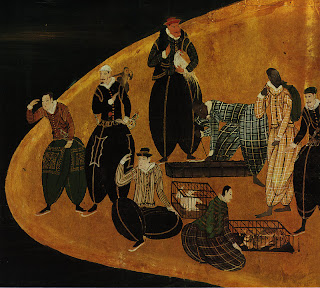
In 1543, the Portuguese arrived in Japan, starting a contact between people was above all a meeting of civilizations. It developed thereafter a commercial and cultural exchange that was recorded in these two pairs of screens.
Thought to compartmentalize the spaces, the screens were usually run in pairs, and is composed of a variable number of sheets of paper hinged covers, topped by a thin lacquer frame. These surfaces, the painter recorded in bold and bright colors, themes that were narrative continuity from the first to the second screen. Daily events highlighted in gold backgrounds were, as a rule, the subject preferred the new Japanese ruling class that emerged in a period of growing political stability was in this context that ordered these screens. In these registers the festive atmosphere and novelty that represented the arrival of the black boat namban jin (barbarians from the south, were designated as the Portuguese) to the port of Nagazaqui.
In the first couple of screens, marked with the seal of the painter Kano Naizen, tell of, from left to right, the preparations for the departure of the ship from a port that is intended to be Goa, intention underscored by the representation of elephants and an architecture other. On the right screen, represents the arrival of the ship at its port of destination in Japan, and the landing of their precious possessions, represented in full detail. Thus, it identifies perfectly the silks of China, exotic animals, and all other goods traded by the Portuguese in various ports of the east, transported in a procession headed by the chief captain of the ship. Rightmost members of various missionary orders awaiting the arrival of this delegation near a church.
In the second pair of screens, paintings attributed to Kano Domi, although having the same issue, the scale is different. On the left screen, negotiates on a ship without sails, while on land it controls the discharge of precious goods, where once again loom the rich Chinese silks in bale or roll. On the right screen, representing himself, led by Captain-General, the procession towards the house of the Jesuits. It follows a group of characters with rich costumes, not omitting the parade the coveted Persian horse, chair Chinese, exotic animals and the famous glazed pots for carrying spices.

The thoroughness with which the various stakeholders are represented, the description of the ship and its precious cargo, and especially determining the presence of Jesuit missionaries, surpass, its meaning, its own visual record, making these pieces a unique document in the context of relationships Portugal and Japan. [source: http://ecultura.sapo.pt/DestaquesDisplay.aspx?ID=349 ; translated See more at: http://translate.googleusercontent.com/translate_c?depth=1&hl=en&prev=/search%3Fq%3DBiombos%2Batribu%25C3%25ADdos%2Ba%2BKano%2BDomi%26client%3Dubuntu%26hs%3DPW6%26sa%3DX%26channel%3Dfs%26biw%3D1301%26bih%3D678&rurl=translate.google.com&sl=pt-BR&u=http://ecultura.sapo.pt/DestaquesDisplay.aspx%3FID%3D349&usg=ALkJrhgwfsJdhlKCj1fg-Af8ZkTu9nJTbA#sthash.5CzFODdy.dpuf]



No comments:
Post a Comment